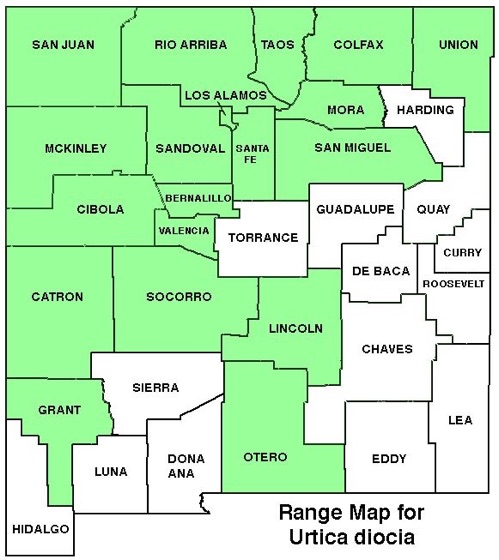WILDFLOWERS OF NEW MEXICO

Brush your bare arms or legs against this innocuous looking 2–6 foot tall plant and you’ll remember it for hours, and not fondly. Bristly, hollow hairs filled with formic acid cover the stem and leaves. Contact causes intense itching and burning pain–for relief immediately wash with water. Note the prickly stem, leaves with rough teeth, and the small creamy flowers that grow in dense clusters from the leaf axils along the stem. Ironically the plant is high in nutritional value and traditional medicinal uses. The two native and one European subspecies cover much of North America.
FLOWER: May–September. Elongated, densely packed clusters of creamy, knobby flowers grow in arching, dangling strands from the leaf axils along most of the stem. Separate male and female flowers grow on the same plant.
LEAVES: Opposite. Blade elliptic to lance-shaped, 2 3/8–8 inches long (6–20 cm); margins coarsely toothed, tip pointed, base tapering to rounded. Stinging hairs on petiole (leaf stem) and bottom leaf surface, which may be mixed with fine, soft hairs. Upper leaf surface hairless.
HABITAT: Moist, rich soils; fields, open woods, stream sides, canyons, slopes, meadows; pinyon-juniper woodlands, ponderosa pine-Douglas fir, spruce-fir forests.
ELEVATION: 5,000–10,800 feet.
RANGE: Widespread across North America, except Gulf Coast states.
SIMILAR SPECIES: Hoary stinging nettle, Urtica diocia subsp. holosericea, has a mix of soft, woolly hairs and stinging hairs on the stem and leaf bottoms. It occurs in CA, ID, NV, OR, WA, and barely into w. CO and no. AZ. The introduced European stinging nettle, Urtica dioica subsp. dioica, has stinging hairs on both sides of the leaf, separate male and female plants, and occurs mainly in the northeast and on the west coast of the U. S. Mountain Nettle, Urtica gracilenta, with a similar range has heart-shaped to oval leaves with even, equal teeth.
NM COUNTIES: Widespread except eastern plains in mid- to high-elevation, moist habitats: Bernalillo, Catron, Cibola Colfax, Grant, Lincoln, Los Alamos, McKinley, Mora, Otero, Rio Arriba, San Juan, San Miguel, Sandoval, Santa Fe, Socorro, Taos, Union, Valencia.

AMERICAN STINGING NETTLE
URTICA DIOCA SUBSP. GRACILIS
Nettle Family, Urticaceae
Perennial herb


THE CONTENTS OF THIS WEBSITE ARE COPYRIGHTED AND CANNOT BE USED
WITHOUT PERMISSION OF GEORGE OXFORD MILLER
EMAIL ME



Flowers grow in crowded strands from the leaf axils along the stem.
The upper leaf surface is hairless and the bottom has stinging hairs, which may be mixed with short, soft hairs.
Stems have scattered stinging hairs.

